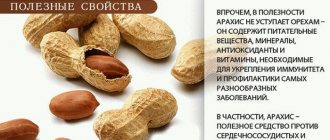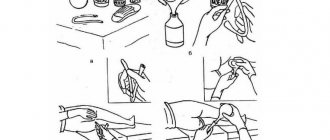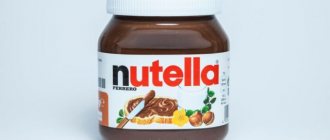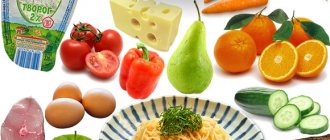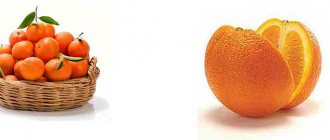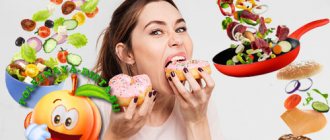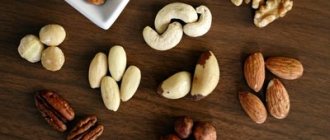Peanut paste is a high-calorie and very nutritious product, and its benefits for the human body are undeniable. Today I want to tell you, dear readers of my blog, why peanut butter is so beneficial? What is its harm, and does it exist at all? Is it possible to have peanut butter while losing weight?? And how to distinguish natural peanut butter from fake? Well, let's get started.
Taste and origin
The classic version of the dish is prepared from a single ingredient. These are carefully crushed roasted peanut kernels.
In modern recipes, nuts are supplemented with vegetable oil, sweet and salty seasonings. The traditional version also remains popular.
Photo: abeautifulmess.com
The consistency of the product is moderately liquid and oily, with small grains of nuts. The taste is slightly mouth-watering and appeals to fans of traditional roasted peanuts. In the refrigerator the mass becomes harder, and at room temperature it softens.
No water is added to the paste. The liquid consistency is due to the peanut oil that is released when the kernels are crushed.
Peanut butter is associated with the American way of life. The recipe was actually born in the USA and has been actively promoted since the end of the 19th century. Pasta was promoted as a filling food for family breakfasts. In this role, she won the love of the people of the United States, and then the rest of humanity. A classic of the genre, familiar from Hollywood films, is sandwiches on toasted toast.
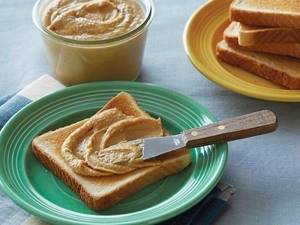
Photo: www.foodnetwork.com
It is also often eaten from a spoon (but in this case it “knits” in the mouth, believe me).

Brad Pitt eats peanut butter in Meet Joe Black
Peanuts are an inexpensive product that is not inferior in nutritional value to meat. He enriched the average American diet with valuable protein and earned universal respect. On January 24, Americans celebrate Peanut Butter Day, and on September 13, the nut itself is celebrated.
Visual test
Natural peanut butter, without the addition of “dubious” oils and preservatives, should have a smooth consistency (without lumps), the color can range from cream to light brown. If cocoa or chocolate is added to the paste, a dark brown tint is possible. There should be no crust or peeling on the top layer of paste.
Reference
If the temperature conditions for storing peanut butter (even natural) are not observed, the top layer of vegetable oil may naturally peel off.
Calorie content and nutritional composition
Peanut butter is a valuable component of the PP diet. Its dietary benefits include plenty of protein, moderate amounts of carbohydrates and 0% cholesterol.
How many calories are in nut butter depends on the specific recipe. Additives can change the energy value either up or down. Average caloric content and nutritional value for 100 g of classic pasta from 1 ingredient: Energy value - 588 kcal
- Proteins - 25 g
- Fats - 50 g
- Carbohydrates – 20 g
The valuable properties of peanut butter for a healthy diet are determined by its mineral composition. It contains the following useful elements:
- Polyunsaturated fatty acids – up to 40% of the paste composition.
- Natural antioxidants.
- Fiber is insoluble dietary fiber.
- Easily digestible vegetable protein (protein). 100 g of paste contains approximately 1/3 of the daily value for an adult.
The daily protein requirement is calculated from the formula: 1 g of protein per 1 kg of body weight.
- Vitamins E, PP, group B.
- Microelements: magnesium, potassium, iron, zinc and calcium.
Reviews from real people
What do consumers think of peanut butter?

Feedback on the forum

Feedback on the forum

Feedback on the forum

Feedback on the forum

Feedback on the forum

Feedback on the forum
There are many reviews, and mostly they are all positive.
Benefit
Nut butter helps maintain a stable weight and is good for weight loss and muscle gain. What are the positive consequences of its regular use:
- A large amount of protein is a plus for athletes building muscle. Protein is the main building material for muscles.
- Fiber improves digestion and promotes the removal of toxins and bad cholesterol.
- An advantage for those losing weight is the presence of unsaturated fatty acids . They speed up metabolism. As a result, food calories do not settle on the sides, but are converted into energy. Thanks to unsaturated acids, the body’s own fat reserves are more actively consumed and leave the body faster.
Natural fatty acids are beneficial for vascular health, improve brain function and increase the strength of bones and tendons.
- B vitamins and magnesium with zinc increase performance and have a positive effect on the nervous system.
- Vegetable oils slow down aging and provide skin elasticity.
- Antioxidants strengthen the immune system.
- The high nutritional value of peanut butter is an added benefit for those on a diet or maintaining their results. Dense protein foods fill you up for a long time, eliminating the desire to snack during the day.
Contraindications
Like any other product, peanut butter has contraindications:
- Peanuts are a strong allergenic product, so peanut butter is contraindicated if you are allergic to the product;
- It is not recommended for people with metabolic disorders;
- In case of individual intolerance;
- With arthritis, arthrosis, salt deposits in joints;
- With exacerbation of chronic gastrointestinal diseases.
Excessive consumption of peanut butter can lead to obesity.
Harm
There are also negative aspects. Moreover, harm can come from both a low-quality product and a product with a perfectly natural composition. The dangers are associated with the specifics of the main ingredient - peanuts.
- High energy value. 100 g of peanut mass (about 615 kcal) in caloric content is equal to ½ the daily value for women (1400-1500 kcal). Excessive indulgence in nut treats will lead to weight gain.
Fats make up more than 50% of the composition of peanuts. They are responsible for the high calorie content.
- Allergenicity. Peanut intolerance is common. It can be congenital and develop from excessive consumption of nut foods.
- Load on the kidneys. Excess protein foods are dangerous for the organs of the excretory system.
- Harmful artificial additives. Synthetic “enhancers” provoke the development of cancer and cardiovascular diseases.
Watch a video that talks about the benefits and harms of peanut butter.
What a Proper Peanut Butter Shouldn't Have
Preservatives, flavors and stabilizers are added to some industrial spreads. Thanks to artificial additives, entrepreneurs save on quality raw materials. “Chemistry” improves the taste properties of a low-grade product and increases its shelf life. Consumers are putting their own health at risk.
A savvy buyer carefully reads the list of ingredients before purchasing. What ingredients should not be present in a good peanut butter:
- Hydrogenated oils are a preservative. For humans, the supplement is dangerous due to slagging of blood vessels and has a bad effect on brain function.
- Palm oil provides a uniform consistency of the substance. Once in the body, low-quality raw materials provoke cancer and cardiovascular diseases.
- Corn syrup is a sweetener, a cheap sugar substitute, and a preservative. Its negative feature is the excess content of fructose, which is instantly absorbed and turns into excess fat.
Contraindications
A categorical ban on consumption is also dictated by the mineral composition of nuts. Who should not be treated to it?
- Children under 3 years old. The reason is the possibility of allergic reactions.
- People suffering from gastrointestinal diseases. The natural fibers that peanuts are rich in irritate the mucous membrane of the digestive organs. Eating nuts in any form will worsen inflammatory processes.
Can pregnant women eat pasta? Doctors recommend abandoning it after 4 months of gestation. Peanuts in the diet of an expectant mother are dangerous for the development of allergies in the baby. Read more about nutrition for pregnant women.
History of origin
The Chinese prepared a paste from peanuts as a base for creamy sauces, and on the African continent it was used instead of starch and flour for kneading dough. Many people mistakenly consider peanuts to be nuts, although this plant is a member of the legume family. The chocolate-nut mass, which was so popular in the Old World, did not give Americans the idea of creating their own original recipe.
At the beginning of the last century, in conditions of a severe economic crisis, the US government popularized the idea of using cheap substitutes for expensive products. Peanuts have become known to everyone as a source of inexpensive vegetable protein. Before this, the campaign was actively carried out by Dr. John Kellogg, who also invented corn flakes. He believed that peanuts would help balance the diet of those who are on a therapeutic diet and are forced to give up meat. It was the doctor who came up with the idea of making a mass not from fried, but from steamed peanuts, which are more beneficial for the body. The Kellogg family founded the first company to produce this product.
Until 1884, pasta was made according to the classic recipe with grinding after heat treatment. As a result, some of the taste was lost and the product turned out bland. Inventor M.G. Edson proposed an alternative and patented a new production technology using two heated surfaces between which the peanut mass was mixed. Already in 1903, a certain Abrose Strobe patented a special apparatus for the production of pasta. In 1922, chemist D. Rosenfield tried to add hydrogenated oil to the paste and obtained a new product. Now they produce two types of paste with different consistencies:
- Thick, homogeneous “creamy”.
- With crunchy crushed peanut pieces.
So that the buyer does not get confused, the lids of the creamy jars are red, while the crunchy jars are marked in blue. Over time, manufacturers began to add syrup, honey, chocolate, and sugar to the product.
How to choose quality pasta
The right product has an even structure without lumps.
Peeling of oil on the surface is normal and a sign of a natural composition.
Color – cream. Shades vary depending on the recipe. If the nuts are crushed together with the skin, the mass will be darker.
Paste with honey and vegetable oil – light. The cocoa product is similar in color to dark chocolate.
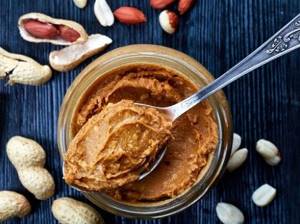
Photo: www.cookinglight.com
Our editors tried many options and we settled on the following American-made option:
We recommend that you try it too. If you bought any other options in the store and liked them, write in the comments which ones.
“Eat and Lose Weight” recommends
Peanut Butter & Co. Peanut Butter Spread, Crunch Time
The jar contains 454 g of excellent crispy pasta. Crispy means with pieces of peanuts, children just love it. Thick, moderately sweet and salty. Rating 4.6 and 3779 reviews on iHerb and product #1 in this category. We tasted it ourselves and it was the best we could find.
View on iHerb
Consumption rate per day
The benefits and harm to the figure depend on the amount of pasta eaten. The daily value is related to the goal of the diet - this can be weight maintenance, weight loss or muscle gain.
To calculate calorie content, you need to know how many grams are in a teaspoon of pasta and its table equivalent:
| Product quantity, g | Energy value, kcal | |
| Tea spoon | 10-12 | 74 |
| Tablespoon | 35 | 217 |
The daily caloric intake for weight maintenance is 1400-1500 kcal for women and about 1800-2000 kcal for men.
It is recommended to consume nut butter in the first half of the day. At this time, metabolism is most active, so fatty and high-calorie foods will give you strength and will not be deposited in the form of extra pounds.
Usage rates depending on dietary goals:
When losing weight, you need to create a calorie deficit and reduce the amount of fat. 1 teaspoon is an acceptable amount during periods of dietary restrictions. A moderate dose of unsaturated fatty acids will speed up the burning of your own reserves.
An energy snack option for those losing weight is an apple accompanied by a nut treat.
When maintaining weight, the allowed portion is correlated with the calorie content of the rest of the diet. The average dose is 1-1.5 tablespoons (about 300 kcal).
Gaining muscle mass is a reason to enrich your diet with protein foods. Athletes can eat up to 3 spoons per day. Exceeding this amount threatens obesity and allergies.
Types of pasta
The classic recipe seems boring and bland to some gourmets. Peanut masses with additives have been created for lovers of bright tastes. They all differ according to 2 criteria:
- Consistency.
- Shades of taste.
The consistency of the paste is creamy and crispy. The first type has a smooth, uniform texture. The crunchy variety contains large pieces of peanuts. The consistency is sometimes indicated on the label: creamy - creamy and crispy - chunky or crunchy.
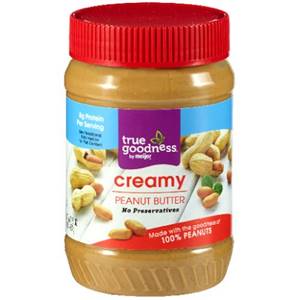
Photo: www.meijer.com
The taste of pasta can be sweet, salty and even spicy. It all depends on the specific additives. What you can choose from:
- Classic (natural) – original recipe from 1 component.
- With salt and sugar - an adapted version, more delicate in taste and consistency.
- With cocoa - a dietary replacement for sweet Nutella. Found in dark and white chocolate.
- With cranberries or lingonberries - good for their high antioxidant content.
- With honey. It completely replaces sugar.
- With dried fruits. Raisins or dried apricots add sweetness and vitamins.
- “Tropical” pasta – with coconut flakes.
- Protein – refers to sports nutrition and is suitable for targeted muscle building. Here, everything that classic pasta is good for is combined with additional protein.
- With cinnamon - lovers of confectionery flavors will like it.
- With maple syrup - a richly sweet option that comes from North American cuisine.
- With garlic and spices - a savory appetizer.
We invite you to watch a video from the “Live Healthy!” program, where they will talk about the composition, benefits and harms of peanut butter, as well as how to choose, how to store and how to prepare the paste.
What to eat with: ideas and recipes
Peanut butter has dozens of uses. 3 main areas of application:
- Breakfasts.
- Snacks.
- Sweet desserts.
During breakfast, nut spread replaces butter or sweet jam. What does it go with?
- Cheesecakes and casseroles.
- Pancakes and pancakes.
- Oatmeal.
- Toasted toast or whole grain bread.
The ideal breakfast for an athlete is cottage cheese and peanut butter. Both components are leaders in protein content. Vegetable peanut oil will improve the absorption of calcium, which is a fat-soluble element.
This snack will keep you energized at work or school and help strengthen your muscles after exercise. There are several options:
- Fresh fruits and vegetables: apples, peppers, cucumbers.
- Cereal breads.
- Cracker. A “sandwich” of 2 crackers sandwiched with peanut butter is an idea. The American delicacy is easy to recreate at home. Even children will enjoy this healthy afternoon snack option.
The best combination: unsweetened peanut butter with banana.
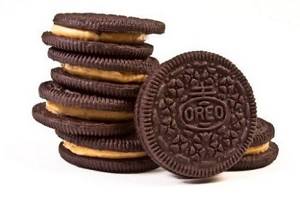
Photo: www.kendrickdisch.com
In dietary baked goods and desserts, the nut mass replaces boiled condensed milk or heavy cream. It is added to the filling of handmade cakes and sweets. The right sweets are not inferior in taste and aroma to Snickers bars.
What recipes can you make at home?
Protein pancakes
Crispy pasta with pieces of nuts is suitable for cooking. Pancakes can be served for breakfast.

Photo: livingsweetmoments.com
| Number of servings | 5 (1 serving – 2 pancakes) |
| Cooking time | 15-20 min |
| Calorie content of 1 serving | 350 |
| Squirrels | 12 |
| Fats | 11 |
| Carbohydrates | 49 |
What you will need:
- Flour – 1.5 cups.
- Granulated sugar - 6 tablespoons.
- Baking powder - 2 teaspoons.
- Salt – ¼ teaspoon.
- Milk 1% fat - 1 ¼ cups.
- Crispy Peanut Butter – ¼ cup
- Vegetable oil – 1 tablespoon.
- Vanillin – ½ teaspoon.
- Chicken eggs - 2 large pieces.
How to cook:
- Break the eggs into a dry deep bowl and beat lightly.
- Sift the flour into another bowl and level it with a knife.
- Add sugar, baking powder and salt to the flour, mix everything well.
- Add milk, beaten eggs, pasta, butter and vanilla to dry ingredients. Mix the dough until a homogeneous consistency is obtained.
- Grease a frying pan with oil and heat it up.
- Fry the pancakes on each side until bubbles appear on the surface of the dough. 1 pancake – about ¼ cup of mixture.
- Protein pancakes can be topped with honey, jam or syrup.
Chocolate candies with banana and peanut filling

Photo: avirtualvegan.com
Sweets are rich in potassium and antioxidants. Chopped nuts combined with dark chocolate and banana create the perfect balance of salty and sweet flavors with a slight bitterness.
For candies, you can use mini muffin tins.
| Number of servings | About 12 pcs. |
| Cooking time | 30 min |
| Calorie content of 1 serving | 120 |
| Squirrels | 3 |
| Fats | 8 |
| Carbohydrates | 9 |
Ingredients:
- Banana – 1 pc.
- Chocolate 70% cocoa – 170 g.
- Nut butter – 3 tablespoons.
How to do:
- Melt the chocolate in a water bath, stirring until completely softened.
- Finely chop the banana. Using a blender, thoroughly mix the fruit with the paste.
- Add a little melted chocolate to the bottom of the small molds.
- Place the banana-nut filling on top of the chocolate layer and pour in the remaining cocoa product.
- Place the pieces in the refrigerator to harden (about 30 minutes).
- Ready-made candies can be lightly sprinkled with coarse sea salt.
Energy bars with granola
Snacks are rich in plant protein, fiber and potassium. The bars are made from 3 ingredients and contain no added sugar.
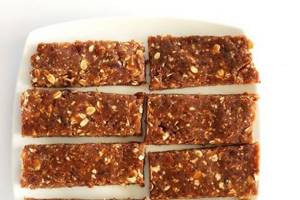
Photo: minimalistbaker.com
| Number of servings | 8 |
| Cooking time | 30 min + (time for cooling) |
| Calorie content of 1 serving | 214 |
| Squirrels | 7 |
| Fats | 9 |
| Carbohydrates | 31 |
What you will need:
- Dates – 30-32 pcs.
- Classic creamy peanut butter - ½ cup.
- Oatmeal - ½ cup.
How to cook:
- To soften the dates, soak them in warm water for 10-12 minutes and then dry them.
- Place the dates in a blender bowl and blend until the mixture forms a sticky ball. If large particles remain, you can cut them with a knife.
- Add date paste and flakes. Continue grinding until the mixture reaches a smooth texture. During the process, you need to stop and scrape the sticky mass from the walls of the blender.
- Place the mixture in a rectangular dish with low sides and level it on top. Place the product in the freezer to harden.
- Cut the cooled mass into 8-10 bars.
- Sweets are stored in the refrigerator for 2 weeks. In the freezer, the mixture remains fresh for up to 2 months.
We invite you to watch a video with 3 different granola recipes.
Classic peanut butter: homemade recipe (non-diet)
It is this recipe that is used to prepare the original American pasta. The product uses natural peanuts with husks. You should not buy roasted nuts, especially with salt or other spices. In this case, nothing will work.
Ingredients:
- 200 g peanuts;
- 1 tsp. honey;
- 2 tbsp. l. refined oil;
- 1/5 tsp. sea salt.
Preparation:
- Place peanuts in a frying pan and fry. It is important not to make the heat too high and to stir regularly. As soon as brown spots appear on the husk, remove the pan and cool the nuts slightly.
- Use your hands to mash the peanuts and husks. After frying, it peels off easily. Next, pour the purified product into a blender.
- Turn on the highest power and start grinding. Gradually, the nuts will turn into crumbs, then into flour, and then oil will begin to separate.
- As soon as the mixture is wet and thick under the blender, you need to add salt and honey. Beat again.
- Check the paste for consistency. If you are not satisfied with it, dilute the oil. The Americans are introducing it without fail. It is important to consider that the nut mass will become thicker after cooling.
The more you roast the peanuts, the richer the nutty flavor will be. But it's important not to overdo it. The scorch marks will add bitterness to the paste.

